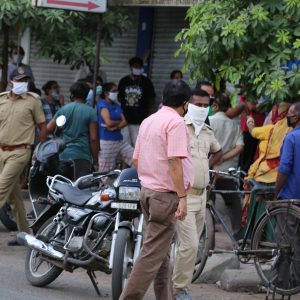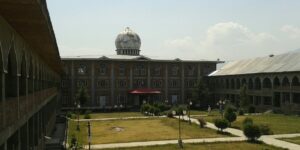
Pandemic-as-war: a narrative that makes lives expendable and widens socio-political inequalities

This essay offers a critical reading of how the pandemic-as-war narrative obfuscates systemic forms of socio-economic oppression while creating ahistorical binaries of us and them, enemy and friend which ultimately help the State evade political responsibility.

In his radio address on 26 April 2020, India’s Prime Minister Narendra Modi while laying emphasis on the need for “selfless endeavor” as a way forward in the wake of COVID-19, called every Indian citizen a “soldier” leading the nation in the “battle” against the novel coronavirus:
“A vast country such as India, with its proactive endeavor on the path of development is fighting a decisive battle against poverty. This is the only medium it possesses to fight the Corona and triumph over it. And we are fortunate that today the whole country; each and every citizen of the country; every person is a soldier in this battle; nay, leading the battle. Cast a glance anywhere, you’ll notice that India’s fight is people driven…” [emphasis added]
This pandemic-as-war narrative was reiterated by Modi in his subsequent address too, where he insisted that the battle against the virus continues to be waged through collective efforts. Alongside doctors and medical workers, added to the list of COVID warriors were also the Indian railways personnel responsible for ferrying thousands of migrant workers home. Indeed, the current pandemic is not the first time that the metaphor of war is being used to describe non-wartime events. Political leaders all over the world have deployed the language of war to convey the enormity of crises or their seemingly spectacular nature such as the Global War on Terror or India’s numerous warsagainst poverty, dark money and so on. While such metaphorical use of war creates a sense of emergency that necessitates an immediate response from the State and the polity, these narratives are often based on and reinforce aggressive heteropatriarchal and racialized discourses such as figure of the “monster-terrorist” in the post-September 11 world. Nevertheless, specific to COVID-19 in India are the affective appeals of “self-reliance” and “sacrifice” that are being made to the national body politic and work towards minimizing the responsibility of the State in averting this crisis. Importantly, these appeals function in complex and contradictory ways: on the one hand, in calling citizens soldiers, they frame all peoples as equal by flattening socio-political differences and marginalities among them. On the other, they allow incriminating an enemy within, who is accused of worsening, if not always plotting, the crisis. Overall, such affective appeals activate what militarization scholar Federica Caso calls the “rhetoric of war” that justifies enforcing a state of emergency and exceptionality.
In this essay, I offer a critical reading of the language and narrative of war that is being mobilized by the Indian State to convey the urgency with which the coronavirus needs to be handled. In doing so, I argue that understanding the pandemic-as-war activates binary distinctions of us and them, war and peace thereby obfuscating systemic socio-economic inequalities – as can also be seen in the recent migrant crisis. Together with appeals of sacrifice for the nation that puts the onus on citizens, pandemic-as-war allows expendability of certain lives in the bigger battle against the virus thus producing and normalizing a state of emergency. This, in turn, creates germane conditions for both militarism and authoritarianism to flourish. Here I briefly discuss the recent political arrests of students, activists and intellectuals, many of whom played active roles in organizing protests against the discriminatory Citizenship Amendment Act (CAA).
Us and them, war and peace
Initial cases of COVID-19 surfaced amid vociferous nationwide anti-CAA protests that had been ongoing since December 2019. Within a few weeks of the bill being passed by the Parliament, protests erupted in many states of India along with social media mobilization, transnational solidarity initiatives and public discussions on the systemic oppression of India’s Muslims as well as Dalit, Bahujan and other marginalized communities. The Muslim-women led sit-in at Shaheen Bagh in Delhi quickly became the pivot of anti-CAA protests inspiring similar demonstrations across the country. This led the ruling Bharatiya Janata Party (BJP) and its supporters to vilify Muslims, label protestors as “traitors” and “anti-nationals” while issuing calls to punish them. Subsequent chain of events – Police brutality against students and protestors, threats and call for violence by a local BJP leader – resulted in an anti-Muslim pogrom in Delhi in February 2020. At least 52 people, mostly Muslims, were killed, mosques were vandalized, and properties and shops destroyed. In the weeks following the pogrom, thousands of Muslims, fearing for their lives, were forced to take refuge in make-shift camps in dire living conditions.
Popular and media discourses on coronavirus spread took on communal overtones with mainstream news channels running lengthy segments on #CoronaJihad and Muslims as “virus carriers” with the pejorative hashtag soon trending on social media. Subsequently, Muslims have been stigmatized, attacked, discriminated in accessing healthcare and socially boycotted with their businesses shunned. As the virus spread in Delhi with a ban on public gatherings, Shaheen Bagh protestors were also forced to disband. Soon after, detection of COVID-19 positive cases among Muslims who had attended a mass religious congregation organized by the international Islamic missionary movement Tablighi Jamaat unleashed a fresh spate of Islamophobia. Popular and media discourses on coronavirus spread took on communal overtones with mainstream news channels running lengthy segments on #CoronaJihad and Muslims as “virus carriers” with the pejorative hashtag soon trending on social media. Subsequently, Muslims have been stigmatized, attacked, discriminated in accessing healthcare and socially boycotted with their businesses shunned. Political anthropologist Irfan Ahmad’s analysis is instructive here in highlighting the demonization of Muslims that continued in its aftermath. Ahmad argues that characterizing Muslims as “corona bombs” and “deliberate carriers” of the virus and linking this spread to terrorism propagated an otherizing discourse, an us versus them where Muslims were yet again framed as the other.
Such politics of othering necessitates that we carefully unpack how the language and rhetoric of pandemic-as-war play into and widen existing socio-political fissures. More specifically, the rhetoric of war relies on binary divisions of us and them, friend and enemy where the other needs to be eliminated. A war always requires an enemy that a nation or a community fights against and emerges victorious over. This allows binarized divisions of us and them – that one is either with us or against us. But is the coronavirus our enemy? It is not. It is a microbe that feeds on and weakens our bodies. In the absence of a visible enemy and, at best, in facing a putative enemy that cannot be seen but attaches itself to our bodies, the pandemic-as-war narrative opens up the possibility of identifying an other, who is being fought against. This raises two points of significance.
First, such a narrative allows externalizing all causes of the ongoing crisis and pinning them on the immediate other who has led us into this moment. This can be seen in the ongoing vilification, harassment and attack on Muslims. Such lack of careful attention towards addressing the underlying causes of the pandemic can also be seen in how richer nations such as the US and the UK along with India have failed to recognize the ways in which racial capitalism and unequal systems of power have produced abject conditions of survival or lack thereof. In a recent talk, political activist and scholar Angela Davis laid emphasis on the need to see this pandemic as a crisis of racial capitalism wherein commodification of healthcare has deeply limited medical access to marginalized peoples, including the failure to provide virus testing to Black people in the US. In addition, the non-availability of universal health coveragecompounded by privatized care systems has made certain gendered, classed, caste, migrant and indigenous bodies more precarious and ultimately perishable. In India, it is evident how lack of proper housing and healthcare, uncertainty of income, food and water supplies – socio-economic marginalization grounded in existing caste and class-based systems of inequality – have even disallowed many to be locked in their homes. So, when the State hurriedly enforced a strict lockdown, who was that for? Where do people without homes take shelter? How do migrants go home? What about queer folk or women for whom homes may be sites of violence? When families are locked inside cramped homes with no clean water, electricity or food supplies, which so-called war are they really fighting?
The pandemic-as-war narrative creates an ahistorical temporal binary of a before and after war. It builds a façade that all was indeed well and peaceful before the pandemic, which is now the sole cause of havoc. Second, the pandemic-as-war narrative creates an ahistorical temporal binary of a before and after war. It builds a façade that all was indeed well and peaceful before the pandemic, which is now the sole cause of havoc. Instead, the pandemic has only laid bare existing socio-economic and political fissures that structured the pre-pandemic world as we now call it. In other words, the pandemic is allowing us to recognize systemic and everyday forms of racism and classism, as Davis also asserts. This requires that we contextualize the Islamophobic discourse of Corona Jihad with the protracted otherization of India’s Muslims or how the migrant crisis is a result of structural caste-based discrimination and informalization of labor with deplorable working conditions. It thus becomes important to understand the unfolding humanitarian crisis and its intersectional complexities not as a one-off event but as symptomatic of the unequal neoliberal economic development that is heralded in a society deeply riddled by Brahmanical supremacy. This requires rethinking the temporal break (normality versus pandemic) that characterizes pandemic-as-war narrative and the linear time of before and after (war) it articulates.
That many impoverished Indians remain more fearful of unemployment, debts and hunger shows how longstanding social inequalities do not even afford many the privilege to think about the fatal risks of the virus amid struggles for everyday survival. Further, when the State deploys pandemic-as-war narrative with affective accompaniments of “self-reliance” and “sacrifice,” it carefully obscures the complexities of caste, class and gendered relations of power that have long persisted while absolving itself of political responsibility or accountability. After all, whose sacrifice is really being demanded? Who can even afford to be self-reliant? This narrative thus creates a perpetual condition of emergency that forecloses possibilities for critiquing the State while obscuring systemic oppression. It is this kind of critical reading, a political and reflexive approach that the language of war tends to obfuscate.
Expendability of lives
In the last week of May 2020, a video of a toddler pulling the shroud off of his dead mother as an attempt to wake her up on a railway platform in Muzaffarpur in eastern India sparked outrage on social media. Many opposing narratives soon emerged: while the Twitter user who posted the video said that the woman had died of hunger and thirst after being on the Shramik special train for migrants for four days, the Police contradicted this claim saying her death was not due to lack of access to food and water as she had been battling “some disease” for the past year. In many ways, this incident is emblematic of the ongoing crisis in India that was exacerbated by the imposition of sudden lockdowns to contain COVID-19. As of 13 June 2020, 884 people have been killed by non-virus issues such as hunger, dehydration and loss of jobs among others. This raises questions that bear repeating: which lives have been sacrificed or left to die in the pandemic? Why were migrant workers not offered adequate time to travel home or resources to sustain in work cities? If this is a war, will all those who have died of starvation, exhaustion and walking hundreds of miles towards their homes be memorialized and valorized like slain soldiers are?
In addition to obscuring the longer histories of caste, class, gendered and racialized oppression, the pandemic-as-war narrative implies that there will be martyrs in the war that is being fought. In her reflection on vulnerability, conflict and migration journalist Francesca Mannocchi asks us to think through the politics of language including the descriptors that are being used to make sense of the pandemic and their complicity in furthering a narrative that evades political responsibility. She argues that when the pandemic is understood as war, there is an “implicit acceptance” that there will be people martyred in the line of duty. While seemingly conveying the urgency of this crisis, the war narrative also allows denial of political responsibility for the lives that are being lost due to State failure and our collective unwillingness to demand accountability. For instance, exemplifying medical doctors and other healthcare workers as frontline heroes underplays their material conditions of work such as lack of basic protective equipment and the myriad forms of State, Police and everyday violence against them. Denial of political responsibility is also visible when office bearers bend to economic interests at the cost of migrant and daily wage workers like the Chief Minister of Karnataka stopping trains for migrants. Here, recommencing construction and industrial activities and concerns over shortage of labor took precedence over the safety of migrant workers and whether they had access to basic necessities including healthcare. Along with denying agency to marginalized workers, the State, in doing so, turns away from constitutional guarantees of medical care and the right to a life of dignity.
This denial of responsibility – and lack of sustained critique – supplementing the pandemic-as-war narrative unfolds at many intersecting scales – political, moral, civil and by the State as well as by privileged citizenry. While many rich Indians have expressed outrage over the deaths of migrant workers, there is little reflection of their own complicity in structures that allow such inequalities to exist. Selective and event-based outrage without questioning the State, demanding accountability and acknowledging one’s complicity in existing injustices only dismisses the long-drawn power differentials that the privileged continue to benefit from. It also becomes a moralizing move that differentiates the “good” citizen who outrages from the “bad” citizen who is silent thus, absolving oneself of political responsibility that, in fact, needs to be centered. Overall, using the language of war and its discursive permutations (such as selective outrage) allow enforcing a condition of emergency in light of an “unprecedented” event. While certainly the speed and scale at which the virus spread was alarming, that the State possesses the resources, methods and access to technical know-how to contain the pandemic is a matter of political responsibility. It is in this sense that the pandemic, unlike war, is not wholly uncertain or unpredictable but can be actively contained. Thus, perpetuating a war narrative only discounts, if not completely denies, the centrality of the State in mitigating such a crisis. Together with inhuman treatment of marginalized peoples in the form of disinfectant showers, week-long train journeys and hunger-related deaths of migrants onboard, the language of war tends to make some lives – migrants, poor, lower caste, tribal – more expendable and sacrificial than others. It is worth noting that pandemic-as-war narrative and the sense of emergency it creates continually constitute and reinforce one another and are then mobilized to justify the expendability of some lives.
These material and discursive mobilizations are also downplayed by symbolic theatrics of switching off lights and banging utensils as a mark of gratitude to essential workers. Dissuading discussion on systematic solutions to socio-economic repercussions of the pandemic, such symbolic gestures often create an illusion of a quick-fix to structural problems. They allow such conditions of expendability to flourish while masking them for the greater good. Instead, we may want to ask: does banging pots and pans as a mark of gratitude to essential workers address their working conditions or how they will be supported by the State? What is the need for military planes to shower flowers on hospitals? Is this enough to address the lack of universal access to healthcare that continually makes some lives more expendable than others? Thus, a critique of the language of war both allows and necessitates careful critique of the State and its responses to the pandemic.
Militarism and authoritarianism
The pandemic-as-war narrative is a militarized narrative. In other words, using the metaphor of war for a health crisis or other non-military events indicates that it is indeed normal to use such an analogy as well as the emergency discourses and tactics that are deployed in war. This in turn, perpetuates militarism – as an ideology and a constant state of war-preparedness – wherein war values and practices are seen as legitimate responses to non-wartime events. Such use of militarized language creates socio-political conditions for militarism to take deeper hold and is variously supported by the State, civil society, religious institutions, among others. For example, along with the Indian State, mainstream news media often describes the pandemic as war. A militarized society thus continually prepares for war in anticipation of danger making militarism ultimately essential for survival.
The support of Indian industrialists to this proposal as a way to address the pandemic-induced unemployment shows the deep reach and intersection of militarism in economic and political interests. Together they construe militarism as a logical response to socio-economic concerns, such as unemployment that has been on the rise for some years now. A news report on 14 May 2020 on the Indian Army considering a proposal that will allow civilians to join the institution for three years distinctly illustrates increased normalization of militarism following the virus outbreak. The report quotes a source saying: “There is a ‘resurgence of nationalism and patriotism’ in the country and the proposal attempts to tap the feelings of the youth who do not want to join the Army as a profession but wish to experience military life for a temporary duration” [emphasis added]. It is worth noting how the military seeks to tap citizens’ feelings of patriotism and nationalism by offering temporary service in officer, logistical and combat roles as part of a voluntary Tour of Duty. This intertwining of militarism and nationalism has only strengthened with the rise of Hindutva espoused by the BJP and the Rashtriya Swayamsevak Sangh (RSS), the party’s ideological guide and a paramilitary organization that imagines India as Hindu Rashtra (Hindu nation). The militarization of Hindus, especially men who reinforce a warrior Hindu masculinity to fight the enemy within (the Muslim other), underpins the establishment of such a rashtra and is reflected RSS’ routine militaristic activities and drills. It is in this sense that Hindutva is grounded in and reinforces militarism’s centrality to the nationalist project. These interconnections are essential to contextualizing the political conditions in which the armed forces may appeal to nationalist youths for undertaking military services. Opening up such experience of military life to civilians only seeks to make militarism more palatable, even desirous, and ultimately normal. Further, the support of Indian industrialists to this proposal as a way to address the pandemic-induced unemployment shows the deep reach and intersection of militarism in economic and political interests. Together they construe militarism as a logical response to socio-economic concerns, such as unemployment that has been on the rise for some years now.
This nexus of militarism and nationalism (especially Hindutva) has led to exalting the armed forces as a near-sacred State institution beyond question or debate. Examples include how anti-war proponents and critics of militarism are branded as seditious anti-nationals and often warranted punitive action. With increased seepage of militarism in socio-economic and political spheres, such curbing of dissent is not only limited to ideas perceived as anti-army but protesting students and activists are routinely called “urban naxals” and part of “tukde-tukde gang” (those who want to divide India). Modi’s labelling of the anti-CAA protests as a political design to ruin the nation’s harmony further illustrates this: “Be it Seelampur, Jamia or Shaheen Bagh, protests were held over the past several days regarding the Citizenship Amendment Bill. Is this performance just a coincidence? No. This is a conspiracy.” Regular shutting down of political dissent as conspiracy heightens authoritarianism by framing democratic disagreements as dangerous to the nation’s fabric and security. Creating this perpetual sense of threat to avoid legitimate dissent has led to the passing of contentious Unlawful Activities Prevention Act (Amendment) (UAPA) which allows the State to designate individuals as terrorists.
With pandemic-as-war narrative boosting this sense of threat and urgency, authoritarian actions have only risen with arrests of students, activists and intellectuals including Anand Teltumbde, Gautam Navalakha, Safoora Zargar (who was granted bail on 23 June 2020), Natasha Narwal and others, many of whom were variously involved in anti-CAA mobilization. Some of them have been jailed under severe charges including the UAPA. Recently, Kashmiri photojournalist Masrat Zahra was also booked under this anti-terror charge for “uploading anti-national posts with criminal intention.” As many of these arrests were made following the COVID-19 outbreak, political prisoners continue to languish in jail in deplorable conditions despite health-related risks. The political timing of these arrests only shows how a war-like pandemic that has normalized militarism, in fact, allows authoritarian politics to flourish at a time when protests are neither safe nor possible.
In this essay, I have offered a critical reading of how the pandemic-as-war narrative obfuscates systemic forms of socio-economic oppression while creating ahistorical binaries of us and them, enemy and friend which ultimately evade political responsibility. This lack of responsibility can also be seen in the lives made expendable by the language of war which makes martyrs out of ordinary citizens. In unpacking how the language of war enables a rhetoric that seeks to normalize militarism, my aim is not to rehearse the insufficient question of whether militarism is good or bad. I also do not wish to further the liberal emphasis often laid on the benign nature of militarism. Rather what remains important is careful examination of the political spaces and times in which war ideology, language and rhetoric are activated and relied upon, how they bolster authoritarian politics and what forms of readings and possibilities of life they (dis)allow, and for whom.





